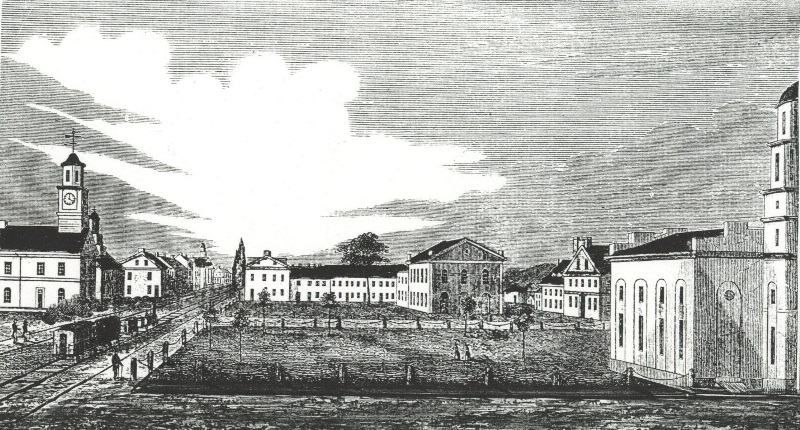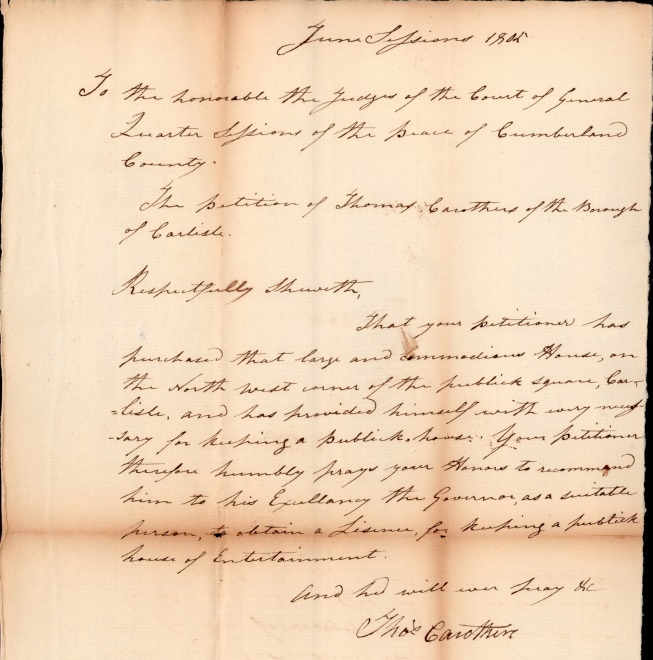In 1805, Thomas Carothers purchased the large stone house on the north west corner of Carlisle’s Square and opened the “Sign of Columbus” tavern.1 The house had belonged to merchant John Montgomery, and it was there that President George Washington hosted a dinner for Governor Thomas Mifflin and Alexander Hamilton on October 4, 1794.2
As well as providing lodging, food and drink for travelers, taverns served as social centers for local residents. Advertisements and items in Carlisle’s newspapers of their day reveal some of the activities that took place at Carothers’ tavern.
Dancing was always popular, and during the 18th and early 19th centuries traveling dancing masters earned their living by teaching the latest dances to members of the public in towns throughout the country.
In 1804, Francis Cezeron, “lately arrived from Paris,” opened a dancing school in Lancaster, PA where he gave classes and practicing balls for several years.3 He left Lancaster in April 1806, and from May through September 1806, he operated both a dancing and a French school at Carothers’ tavern in Carlisle. Cezeron advertised that he taught the most fashionable dances, cotillions and waltzes and would instruct pupils in manners and politeness. He charged $8 per quarter, held classes three times a week and charged one dollar per pupil, upon entrance, to defray the cost of the room. Gentlemen were instructed from 5 in the evenings to 7 and ladies from 11 in the morning until one. French lessons were $8 per quarter and were held daily.4 Practicing Balls were held after several weeks of lessons, and Mr. Cezeron had planned a Ball for July 23, but it had to be postponed because of the “indisposition of the musician.” He advised the public to buy their tickets for half a dollar at Mr. Carothers’ bar.5
Balls and dances were held for many different occasions such as the “splendid ball given at Mr. Carothers’ which was attended by a large number of Ladies and Gentlemen of the Borough” in February 1811 to commemorate George Washington’s birthday.6
James Miller McKim, a Presbyterian minister and abolitionist, was born in Carlisle in 1810. In 1872, two years before his death, he wrote several lengthy reminiscences of the Carlisle of his youth. They were published in the Carlisle Weekly Herald under the pen name AGC (A Genuine Carlisler). The following description of Thomas Carothers and his tavern was published in the February 8, 1872 edition of the newspaper.
“We come to Carothers’ corner, the stage office and the chief public house of the town. Though a sunny nook, it used to be shaded by a row of locust trees, under which, on any fine day, might be found a group of Carlisle’s men of leisure—a class which in number, and devotedness to their calling, was not exceeded by that of any town twice the size, north of Mason’s and Dixon’s line.
Mr. Carothers house was the stopping place for distinguished travelers, and it was here that Mr. and Mrs. Clark, the celebrated dwarfs of 50 years ago, made their home while giving concerts in the town. They were charming singers and their concerts, which were given in the County Hall, will be remembered by some readers. The duet of “Sandy and Jenny” which they introduced and popularized, was all the rage for a while after they left, and the tune of it, years afterwards, used to be reproduced by “Tom Watts” and “Reub Alexander” when those two worthies happened to meet, which they often did at the Meeting House pump. As whistlers, Tom and Reub had no peers.
When Mr. Carothers retired from public life the good will and custom of his stand were transferred to his brother-in-law, Mr. James Bell, who had taken the house previously occupied by Mr. Fogle (The Carlisle Hotel, later called the Mansion House on the southwest corner of High and Pitt streets) The Carothers’ property passed into the hands of Mr. Thomas C. Lane and was by him used as a store for the sale of dry goods and groceries.”7
Before coming to Carlisle in 1805, Carothers kept “Walker’s Tavern” in East Pennsborough Township. Like many tavernkeepers, Carothers was a "slave" owner. The 1800 census recorded eight people in Carothers’ household including one "slave." When the census was taken in Carlisle in 1810, there were sixteen people in residence at Carothers including three "slaves." Two of these "slaves" were likely Hannah, born on February 11, 1800 and Charles born on April 3, 1808. The 1820 census recorded that all three "Negroes" in his household were free.8
Carothers’ wife, Elizabeth Loudon, died in 1814 leaving him with several children to raise. He retired from tavernkeeping in 1821 and returned to East Pennsborough Township. His children married, and he moved to Bellefonte, Centre County, Pennsylvania to live with his daughter Nancy and her husband Alfred Armstrong. He died there on May 14, 1851, aged 81.9 He is buried in the graveyard at Silver Spring Presbyterian Church with his wife Elizabeth (1774-1814).

